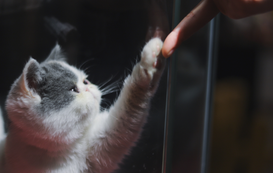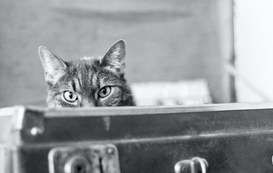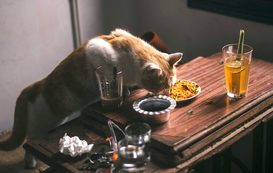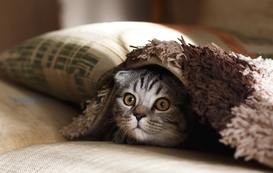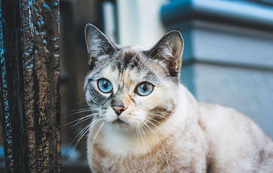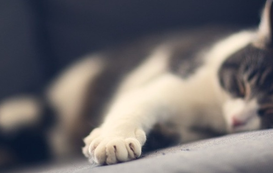- Home
- Cat Sitter Blog
- Cat Behavior
- 7 Cat-Safe Indoor Plants


7 Cat-Safe Indoor Plants
Creating a cat-friendly home involves more than cozy beds and engaging toys; it extends to the thoughtful selection of houseplants to adorn your space.
Your furry friends are naturally curious about practically everything, including greenery. As such, pet owners with green thumbs should choose non-toxic plants to protect their four-legged companions. Keep your feline friend safe by avoiding common poisonous plants that affect cats. From lush, polka-dot plant foliage and variegated green leaves to vibrant orchid blooms, there are many cat-friendly plant options that’ll help you and your pet feel right at home.
Cat-Safe Indoor Plants
Ponytail Palm
The ponytail palm (Beaucarnea recurvata) is a cat-friendly succulent known for its distinctive long, cascading leaves resembling a ponytail. This low-light plant stores water in its base, making it drought-tolerant and forgiving. Its non-toxic nature makes it a safe and stylish addition to homes with curious feline companions. Similarly, the bamboo palm and parlor palm are also safe.
Pilea Peperomioides
The Pilea peperomioides, commonly known as the money plant or Chinese money tree, is generally considered safe for cats. This attractive and easy-to-care-for plant thrives in indirect light and features round, coin-like leaves on upright stems. Will the cats play with the bouncy leaves? Very likely. Will they get sick? Probably not! Similarly, the Peperomia obtusifolia (or baby rubber plant) is also cat-friendly. It’ll thrive on your cat’s favorite window ledge in direct sunlight.
Boston Fern
The Boston fern (Nephrolepis exaltata) is a popular cat-friendly choice with lush, feathery fronds. This low-light plant is not only visually appealing, but also acts as a natural air humidifier, making it an excellent addition to indoor spaces. Cat owners can enjoy the greenery without worrying about harm to their feline friends.
Areca Palm
The areca palm (Dypsis lutescens) is a cat-safe plant known for its graceful, arching fronds. This tropical plant thrives indoors in indirect light, adding a touch of elegance to any room. Its non-toxic nature makes it a safe and beautiful option for cat-friendly households.
Bird’s Nest Fern
The bird’s nest fern (Asplenium nidus) is another cat-friendly fern species with its attractive nest-shaped fronds. Known for its air-purifying properties, this plant is both visually appealing and beneficial for indoor air quality. Pet owners can enjoy the greenery without worrying about potential harm to their furry companions.
Air Plants
Air plants (Tillandsia) are unique, cat-safe plants that don't require soil. These low-maintenance plants can be displayed in creative arrangements and are perfect for cat owners who want distinctive greenery without the need for traditional pots. Their non-toxic nature makes them a safe choice for homes with cats.
Calathea Orbifolia
The Calathea orbifolia is a cat-friendly plant admired for its stunning, round leaves with silver zebra stripes. This pet-safe plant is a favorite among cat owners who appreciate its unique foliage and low-maintenance care. Its non-toxic properties ensure that it can safely coexist with feline friends in your home.
Where Can You Find Cat-Safe Plants?
Cat-safe plants are available in stores and online. Be sure to check the following places if you’re introducing new plants into your home:
- Local nurseries
- Farmers markets
- Botanical gardens
- Pet supply stores
- Online retailers
In addition, propagating your own plants from seeds or cuttings is a great way to expand your collection of safe indoor plants.
What Plants Are Safe for Cats to Eat?
Several pet-friendly plants are not only non-toxic, but also safe for cats to nibble on. Here are some plants that are generally considered safe for cats. Just remember, everything in moderation:
- Catnip (Nepeta cataria)
- Cat grass (Dactylis glomerata)
- Valerian (Valeriana officinalis)
- Spider plant (Chlorophytum comosum)
- Cilantro (Coriandrum sativum)
- Basil (Ocimum basilicum)
Always ensure that any plants offered to cats are free from pesticides or other harmful substances.
What Should I Do if My Cat Is Eating My Plants?
If your cat is munching on your houseplants, there are several steps you can take to address this behavior:
- Identify safe plants. Ensure that the plants in your home are non-toxic to cats. Refer to lists of cat-safe plants, such as the one from the ASPCA, and remove any potentially harmful ones.
- Introduce cat grass, catnip, or other plants that are safe to nibble. This helps redirect their attention away from plants they should avoid.
- Use deterrents. Applying cayenne pepper, citrus peels, diluted vinegar, or commercial pet deterrent sprays can discourage cats from chewing.
- Supervise and redirect. Whenever possible, supervise your cat around plants. If you catch them in the act, gently redirect their attention to a more appropriate cat toy or a safe plant.
- Create barriers or relocate your plant. Place physical barriers, like mesh or decorative rocks, or a terrarium around plants to make them less accessible to your cat. You might also consider hanging baskets to keep them out of reach.
You’ll feel better about leaving town once you’ve made a safe space for your cat. If you need someone to take care of your furbaby, book professional cat sitting services with Meowtel. Our experienced, cat loving sitters undergo thorough background checks, so you can have peace of mind while they’re in your home and taking care of your cat. When you need a reliable in-home cat sitter for your beloved pet, Meowtel is your trusted choice. Find the purrfect cat sitter near you with Meowtel.











